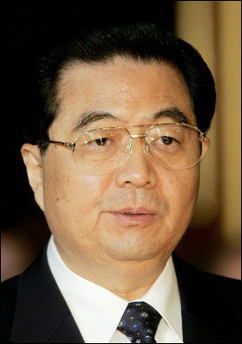|
Hu inaugurates exhibit on Chinese emperors in London
(AFP)
Updated: 2005-11-09 00:50
China's President Hu Jintao prepared to inaugurate a landmark exhibition
displaying the artistic riches created for China's most powerful emperors who
reigned more than two centuries ago.

China's President Hu Jintao prepared to
inaugurate a landmark exhibition displaying the artistic riches created
for China's most powerful emperors who reigned more than two centuries
ago. [AFP] |
Hu and Queen Elizabeth II, his hostess during his state visit to Britain,
were to be on hand for the inauguration of the exhibition at 3:10 pm (1510 GMT)
at the Royal Academy of Arts in London, which opens to the public on Saturday.
Hu arrived in London on Tuesday at the start of a tour that will also take
him to Germany and Spain.
The exhibition here spans the reigns of three emperors from 1662 to 1795,
featuring more than 400 treasures, mostly from the Forbidden City, the vast
former imperial palace complex in the center of Beijing which is now a museum.
It "will include such treasures as paintings and painted scrolls, jades and
bronzes, porcelain and lacquer ware, precious robes, palace furnishings,
scientific instruments, weapons and ceremonial armor," the academy said.
"Many of these unique objects have never been shown outside China," it said
in a statement to the news media.
The emperors all formed part of the Qing dynasty, led by ethnic Manchus from
the northeast who conquered China in the 1640s and who ruled China until their
overthrow in 1911.
They are Kangxi, emperor from 1662 to 1722; Yongzheng, who ruled 1723 to
1735; and Zianlong, in power from 1736 to 1795.
The three emperors also rode into battle to extend their lands west and
north, reaching Central Asia and Mongolia, and used art and culture to help
consolidate their hold over the vast territories and their 56 separate ethnic
groups.
Art served as "part of an elaborate form of legitimation", since it showed
the emperors' due respect for antiquity and broadcast the glory and power of the
state, said Oxford dean Jessica Rawson, a China specialist and one of the show's
curators.
The emperors' own calligraphy will be seen at the academy, alongside highly
symbolic still life and landscape paintings, ritual portraits and ceremonial
armor of the rulers, giant scrolls, porcelain and lacquer objects and jades.
The exhibit will also feature work by Jesuits who advised the Qing court in
the 17th century, bringing technical expertise -- in the form of clocks and
scientific instruments -- and Western artistic influence.
Rawson said the China exhibit would be one of the most extensive ever held
abroad, including those hosted in Paris in 2003-4 as part of a special "China in
France" year, since it focuses on three emperors instead of one, as has been the
case in notable recent Western shows.
It also contains more premium artefacts from the Palace Museum -- now the
official name for the Forbidden City -- than any other exhibition staged abroad,
and most of those which will come to London have never before left China.
The Royal Academy's first exhibition on China, staged in 1935 with an
expansive historical focus from the Bronze Age to the 16th century, remains the
museum's most popular exhibition ever.
|